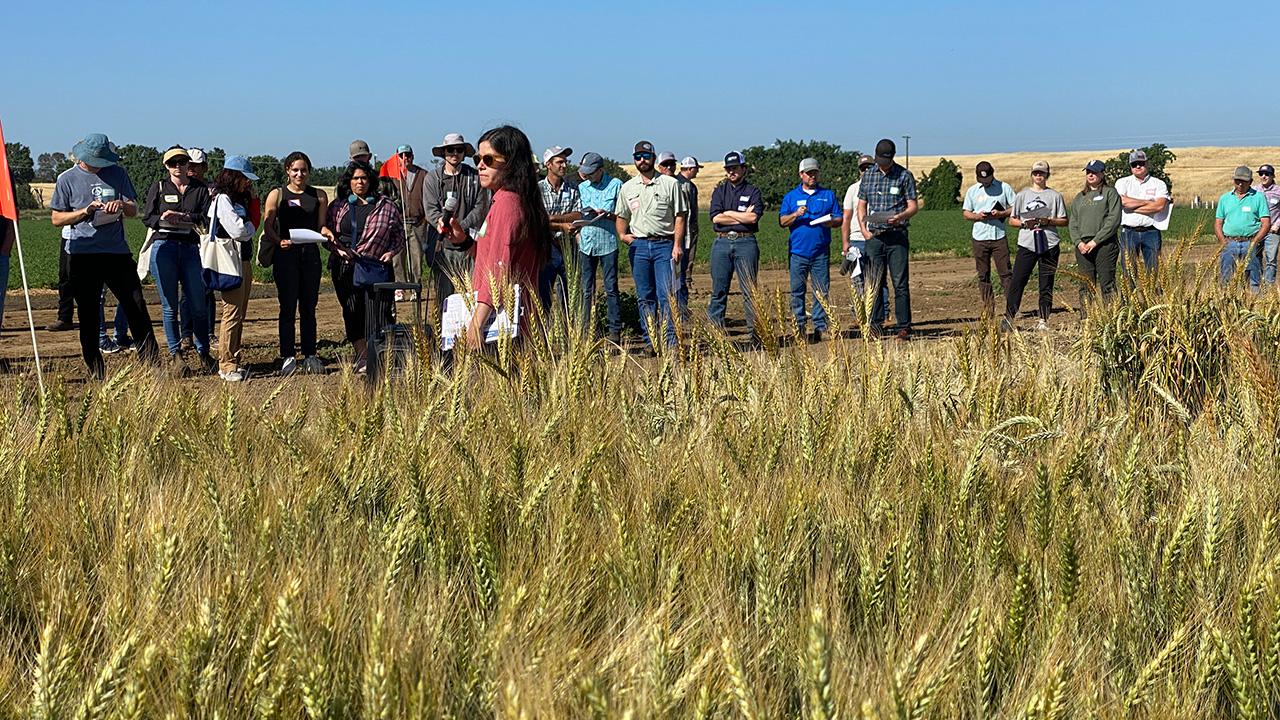
Alfalfa research: Maintain yield, reduce climate-altering gases
More studies measure fertilizer, field emissions
Quick Summary
- There is potential for overall lower greenhouse gas emissions in alfalfa cultivation using standard cultivation practices.
- Whether certain organic amendments increase GHG emissions appears to vary by season.
Researchers in the UC Davis Department of Plant Sciences are looking at how agriculture can reduce the climate-warming greenhouse gases produced by the sector. They discussed some of their findings during the recent Small Grains/Alfalfa Field Day, hosted by the department.
Their work is significant because gases that are produced naturally in agricultural soils contribute to unnaturally warm temperatures, as do carbon dioxide emissions from burning fossil fuels. Higher temperatures, in turn, contribute to increasingly severe weather and wildfire. Agriculture and the global food system together create about one-third of these greenhouse gases world-wide, and nitrogen fertilizers are a major source.
The good news: Scientists are finding ways to both reduce greenhouse gases and boost yields.
Alfalfa: Potential for overall lower climate impact

Alfalfa is a crucial animal feed in the United States, but opportunities for reducing GHG emissions from alfalfa cultivation has received little attention. When weighing inputs such as water and fertilizer, benefits to soil health, and what fields give off in weather-warming emissions, there are unique aspects of alfalfa production that may offer a climate-smart alternative compared to other grain or silage feed sources.
Cameron Pittelkow, an associate professor in the department, is looking at the major alfalfa production areas in California: the intermountain north, the Central Valley and the low-desert south. His team is estimating the GHG footprint of alfalfa in those areas based on common farming practices, and how to reduce those emissions depending on the main sources in each region.
In their calculations, they’re including the additional benefits alfalfa can provide that mitigate against GHGs: It's a deep-rooted perennial crop; it improves the soil by storing more carbon; and farmers can use less nitrogen fertilizer on other crops when they rotate with alfalfa. These strategies can offset or reduce GHGs at the systems level, while saving farmers money.
Preliminary results from Pittelkow’s research varied by region. Results depended on irrigation source (surface water vs. ground water, which requires more electricity for pumping) and the number of cuts each season (more harvests help produce higher yields, but also require more field operations and use more fuel).
Accounting for soil carbon gains and reductions in nitrogen fertilizer can lower GHG emissions by almost half in some locations. Meanwhile, electrifying irrigation pumps and harvesting equipment would further reduce emissions without impacting alfalfa productivity, Pittelkow reported. Results are being shared with growers for feedback and to improve estimates in this project, funded by the National Alfalfa & Forage Alliance.
Dan Putnam, a renowned alfalfa expert and professor emeritus of Cooperative Extension, is working with Pittelkow on the project. Also contributing are graduate students Phoo Pye Zone, Valentina Roel-Rezk, and former postdoc Virginia Nichols.
Alfalfa is a significant crop in California, contributing to the state’s $14-billion dairy and cattle industries in 2022, according to the state Department of Food and Agriculture.
Read more about Pittelkow’s work here.
Organic soil amendments improve yield, but emissions vary
Doctoral student Valentina Roel-Rezk has been looking at ways to use the byproducts of green waste processing to boost crop yields. So far, she has found these forms of fertilizer significantly boost triticale and sunflower yield. They also increase organic carbon in the soil after both one and two years.
For winter non-irrigated crops, the yield using these amendments was similar to that in fields using urea, Roel-Rezk found.
Roel-Rezk is also measuring climate-warming gases given off by her trial fields. During the winter, the organic amendments did not increase gas emissions. However, she found that during the summer, the amendments did tend to increase emissions of nitrous oxide, the third most-significant gas that contributes to extreme weather.
Read more about Roel-Rezk’s research on using green waste byproducts as alternative fertilizer here.
The gases that make the greatest contribution toward warming weather and severe weather events are carbon dioxide, methane and nitrous oxide. All have greatly increased in the atmosphere due to human activities in the last 300 years.
Related links
Read more about this year’s UC Davis Small Grains/Alfalfa Field day here. [Link to other story]
Media Resources
- Trina Kleist, UC Davis Department of Plant Sciences, tkleist@ucdavis.edu, (530) 754-6148 or (530) 601-6846.
